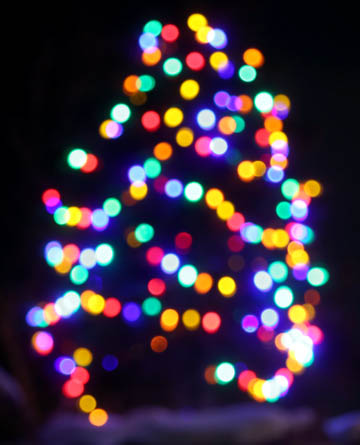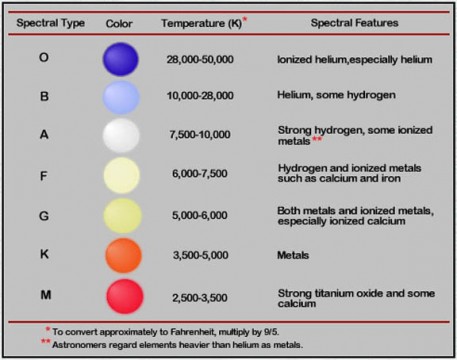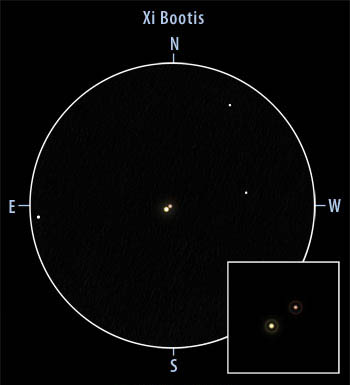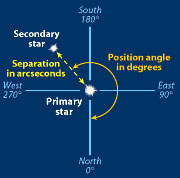Astronomy - Colored Double Stars, Real and Imagined
Colorful lights twinkle everywhere during the holiday season, including up above in some remarkably tinted double stars. Find out what makes them so alluring.

Color delights the eye as in this tree decorated with holiday lighting. How we perceive it in our telescopes sometimes depends on context.
Bob King
Bob King
Stars show different colors depending on their temperature. Red ones are cooler, orange ones hotter, and blue hotter still. Every star emits light of all wavelengths, but cooler ones radiate more of their light in the red end of the spectrum compared to stars like the Sun with a peak output in the yellow-green. It's no coincidence that that's also the same spectral zone in which are eyes are most sensitive.
Now, pair two different colored stars in a binary system, and the human brain works a strange magic. If the brighter of the two is red or orange colored, the fainter secondary, if it's white, will take on the complementary color of the primary or in this case, blue or green.
What's more, the pseudo-blue star in turn helps to further enhance the color of the primary, making color perception an organic experience in which the observer is intimately involved.
Take Albireo. Some observers see gold and blue, others yellow and white. Based on the spectral classification K2II (warm-toned) and B8 (close to pure white) for the secondary, it would seem that for many observers, the complementary color effect is at play.

The double star Albireo in Cygnus is a colorful favorite for any pair of binoculars or telescope. The secondary's color varies due to complementary color contrast.
Jeremy Perez
Jeremy Perez
The only way to tell fact from fancy is to hide each star in turn and examine them separately. When I tried this the other evening, I was surprised at how the secondary lost its familiar blue hue, though the primary still glowed golden.
Next come the doubles where each star really does have a distinctly different hue based upon its spectral type. These may appear more genuinely colored visually, but with some, the complementary color effect can magnify their difference even more.

This diagram describes the basic stellar spectral types with information on temperatures and what elements and compounds show up in their spectra.
Eugene R. Zizka
Eugene R. Zizka
Many amateurs seek out or happily stumble upon colorful double stars, whether those colors are "fake" or real. Red stars in particular are high on many observers' lists, as are the even rarer blue-white suns. Color adds beauty, character and a certain excitement to double star observing. We delight in contrasting colored light otherwise why our fascination with stained glass and rainbows?

The double star ξ Bootis shows striking a striking color difference between primary and secondary. I saw yellow and rose as depicted here.
Jeremy Perez
Jeremy Perez
To feed the color beast within, I've prepared a list of double stars that include those with true color contrast based on spectral type as well as those with complementary color contrast. I've included the classifications — OBAFGKM — to help you determine the color difference of each double using a method Sky & Telescope's Alan Adler employed a decade ago.
Alder compared each star's spectral class. If the stars were a single letter apart, as in G and K, the color difference between them was equal to 1. Gamma (γ) Andromedae (Almach) with a B8 class primary and K3 secondary, has a spread of 3.5, making it one of the more colorful doubles. The greater the number, the more strongly contrasting the components. If you notice a strong color difference and the spectral types don't indicate one, consider yourself a happy victim of spurious color!

The two measures of a double star are separation and position angle. The directions shown here are for an inverting scope, such as a Newtonian reflector.
Sky & Telescope
Sky & Telescope
As a general rule, O stars offer a hint of blue; B and A appear white; F and G look yellow (pale yellow on the F end); and K and M shine orange and ruddy-orange respectively. Numbers follow each letter from 0 to 9; the higher the number, the closer the star is to the next cooler class. In the table below, the spectral class of the primary is given first.
About magnification. For most of the listed doubles, low magnification (64× for me) worked well, but in the case where the two stars were close, I increased that to 124× to better separate the components and distinguish individual colors. One of the most interesting and unexpected results of my observations was that I could intensify the complementary color of a white companion star by keeping most of my attention on the primary star while still taking in the secondary. If instead I focused on the white secondary, its color would vanish. Try it and see how it works for you!
| 22 Contrasting Color Double Stars | |||||||||
| Star | R.A. Dec. | Mags. | Sep. | P.A. | Color difference | Spec. Class | |||
| η Cas | 00h 49m | +57° 49' | 3.5 | 7.2 | 13" | 317° | 1.7 | G0, K7 | |
| 1 Ari | 01h 50m | +22° 16' | 5.9 | 7.2 | 2.9" | 164° | 3.5 | K1, A6 | |
| γ And | 02h 04m | +42° 20' | 2.1 | 4.8 | 9.8" | 64° | 3.5 | K3, B8 | |
| ι Tri = 6 Tri | 02h 12m | +30° 18' | 5.3 | 6.7 | 4" | 69° | 1 | G5, F5 | |
| η Per | 02h 51m | +55° 54' | 3.8 | 8.5 | 28" | 301° | 3 | K3, A3 | |
| 32 Eri | 03h 54m | –02° 57' | 4.8 | 5.9 | 7" | 254° | 2.6 | G8, A2 | |
| ρ Ori | 05h 13m | +02° 52' | 4.6 | 8.5 | 7" | 64° | 1.7 | K3, F7 | |
| 14 Aur | 05h 15m | +32° 41' | 5.0 | 7.4 | 15" | 226° | 0.4 | A9, F3 | |
| ι Ori | 05h 35m | +05° 57' | 2.9 | 7.0 | 10.9" | 142° | 0.2 | O9, B1 | |
| γ Lep | 05h 44m | –22° 27' | 3.6 | 6.3 | 97" | 350° | 1.6 | F6, K2 | |
| h3945 CMa | 07h 17m | –23° 19' | 5.0 | 5.8 | 26.8" | 52° | 2.0 | K0, F0 | |
| ι Cnc | 08h 47m | +28° 46' | 4.0 | 6.6 | 30.6" | 307° | 2.6 | G8, A2 | |
| 24 Com | 12h 35m | +18° 23' | 5.1 | 6.3 | 20" | 270° | 2.2 | K0, A9 | |
| ξ Boo | 14h 51m | +19° 06' | 4.8 | 7.0 | 6" | 343° | 0.5 | G8, K4 | |
| α Her | 17h 15m | +14° 23' | 3.1 | 5.4 | 5" | 106° | 1.7 | M5, G8 | |
| 95 Her | 18h 02m | +21° 36' | 4.9 | 5.2 | 6" | 258° | 2.3 | A5, G8 | |
| ζ Lyr | 18h 45m | +37° 36' | 4.3 | 5.6 | 44" | 150° | 1.1 | B7, A8 | |
| Albireo | 19h 31m | +27° 57' | 3.4 | 4.7 | 35" | 54° | 3.5 | K3, B8 | |
| 31 Cyg | 20h 14m | +46° 44' | 3.8 | 4.8 | 107" | 325° | 2.9 | K2, B3 | |
| β Cap | 20h 21m | –14° 47' | 3.2 | 6.1 | 207" | 267° | 3.2 | K0, B8 | |
| γ Del | 20h 47m | +16° 07' | 4.4 | 5.0 | 9" | 267° | 1.4 | K1, F7 | |
| δ Cep | 22h 29m | +58° 25' | 4.1 | 6.3 | 40.9" | 191° | 2.5 | G2, B7 | |
| Data are from recent catalogs. Right ascension and declination are for equinox 2000.0 | |||||||||
Observing notes:
- Eta (η) Cas: My favorite! Exquisite at 64× with a pale yellow primary and purple-red secondary.
- 1 Ari: A close pair. I see orange and blue — good example of complementary color.
- 14 Aur: Yellow and pale orange; subtle.
- η Per: Reddish-orange and blue-green. A splendid color mix and yet another example of complementary color.
- 32 Eri: Yellow-orange and blue. A close pair, so use 100× or higher to see the colors more clearly.
- Iota (ι) Ori: Two pure white suns. No color difference, so no false contrast here!
- Gamma (γ) Lep: Striking gold and green! Of course, since there are no green stars, we know perception alone is at play.
- h3945: The "Winter Albireo" and a perennial favorite. Perceived color differences are real in this binary.
- Xi (ξ) Boo: A lovely yellow and rose duo. The delicacy of the tints is a delight.
- 95 Her: The red and white colors I see are even more striking because both stars are the same magnitude.
No comments:
Post a Comment